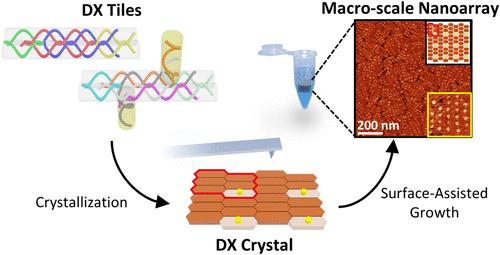垂直DNA纳米结构阵列:促进宏观尺度表面的功能化
IF 16
1区 材料科学
Q1 CHEMISTRY, MULTIDISCIPLINARY
引用次数: 0
摘要
在纳米尺度上具有多种功能化和精确控制的能力是DNA纳米结构的显著优势。在DNA纳米结构的组装中,利用双交叉(DX)瓦片结构的表面辅助生长方法有助于在相对低浓度的表面上基于静电相互作用成核,从而实现大面积的晶体生长。然而,在表面辅助生长中,DX瓷砖结构表面上垂直结构的几何阻碍使得将DNA纳米结构共轭到制造表面具有挑战性。在这里,采用表面辅助生长的方法扩展了DX瓷砖生长,在衬底上形成垂直结构阵列,在宏观尺度上为均匀覆盖的衬底提供了功能化的附着位点。此外,通过构建DX晶体的重复单元瓦片的战略设计,证明了垂直结构阵列的间距是可控的。本文章由计算机程序翻译,如有差异,请以英文原文为准。

Vertical DNA Nanostructure Arrays: Facilitating Functionalization on Macro-Scale Surfaces
The capability for varied functionalization and precise control at the nanoscale are significant advantages of DNA nanostructures. In the assembly of DNA nanostructure, the surface-assisted growth method utilizing double-crossover (DX) tile structures facilitates nucleation at relatively low concentrations on the surface based on electrostatic interactions, thereby enabling crystal growth over large areas. However, in surface-assisted growth, the geometrical hindrance of vertical structures on the DX tile structure surface makes it challenging to conjugate DNA nanostructures into fabricated surfaces. Here, the surface-assisted growth method was employed to extend the DX tile growth for forming vertical structure arrays on the substrate, providing attachment sites for functionalization on uniformly covered substrates at the macroscopic scale. Additionally, the spacing of the vertical structure arrays was demonstrated to be controllable through the strategic design of the repeating unit tiles that construct the DX crystals.
求助全文
通过发布文献求助,成功后即可免费获取论文全文。
去求助
来源期刊

ACS Nano
工程技术-材料科学:综合
CiteScore
26.00
自引率
4.10%
发文量
1627
审稿时长
1.7 months
期刊介绍:
ACS Nano, published monthly, serves as an international forum for comprehensive articles on nanoscience and nanotechnology research at the intersections of chemistry, biology, materials science, physics, and engineering. The journal fosters communication among scientists in these communities, facilitating collaboration, new research opportunities, and advancements through discoveries. ACS Nano covers synthesis, assembly, characterization, theory, and simulation of nanostructures, nanobiotechnology, nanofabrication, methods and tools for nanoscience and nanotechnology, and self- and directed-assembly. Alongside original research articles, it offers thorough reviews, perspectives on cutting-edge research, and discussions envisioning the future of nanoscience and nanotechnology.
 求助内容:
求助内容: 应助结果提醒方式:
应助结果提醒方式:


